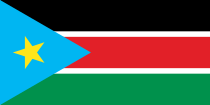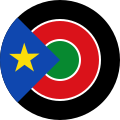Flag of South Sudan
 | |
| Use | National flag |
|---|---|
| Proportion | 1:2 |
| Adopted | 9 July 2005 9 July 2011 (as national flag) 25 August 2023 (standardized) |
| Design | A horizontal tricolour of black, red, and green, fimbriated with white stripes; with a sky-blue equilateral triangle based on the hoist side bearing a yellow star |
| Designed by | Samuel Ajak[citation needed] |
 | |
| Use | |
| Proportion | 1:2 |
The flag of South Sudan was adopted following the signing of the Comprehensive Peace Agreement that ended the Second Sudanese Civil War.[1] A different version of the flag was previously used as the flag of the Sudan People's Liberation Movement. The flag of South Sudan predates the country, as the flag was adopted in 2005, while the country became independent in 2011.[2][3]
History
[edit]When Sudan became independent in 1956, the predominantly Christian and Animist people living in the south of the country had no regional symbols, while the already dominant Muslim north displayed Islamic symbols on the national flag. Before independence, the British government had arranged for appropriate local symbols for the regions in Sudan, but the new government in independent Sudan had opposed the use of these symbols as being counterproductive to fostering national unity.[citation needed]
From the outset, the southern Sudanese felt discriminated against by the Islamic north. The southerners fought the Second Sudanese Civil War to gain their independence, followed by a peace agreement in 2005 that included a referendum on independence in the south. The referendum passed with overwhelming support in 2011, and South Sudan became officially independent on 9 July. In the 1990s, during their struggle with the north, the southern Sudanese had created a banner of independence, which would become the new national flag. The flag was designed by Samuel Ajak,[citation needed] who was an artist and brigadier general for the Sudan People's Liberation Army under revolutionary leader John Garang.[4] However, the flag was never actually defined in detail, which led to misunderstandings regarding its official colours or the rotation of the star on it.
To address the discrepancies, on 25 August 2023, the Media Authority of South Sudan released an advisory to advertisement and printing companies identifying the correct version of the flag as having a light blue chevron and upright star. It is now illegal in South Sudan to distribute alternate reproductions of the flag which feature a dark blue chevron or tilted star.[5]
Description
[edit]The flag bears similarities with the flags of Sudan and Kenya. It shares the black, white, red, and green of the Sudanese flag (although the colours' symbolism are different), in addition to having a chevron along the hoist. The horizontal black, white, red, and green bands of the flag share the same design as the Kenyan flag, and the Pan-African symbolism thereof. Another difference between the flags of Sudan and South Sudan is that there is a yellow star inside the blue triangle (like the flag of the Belgian Congo), representing the unity of South Sudan.[6][circular reference]
Since the flag was adopted, there have been disagreements about whether the star should be tilted to the right slightly or upright, and whether the chevron should be dark blue or sky blue. The fixed and tilted stars were both used at John Garang's funeral in 2005.[citation needed] Variants of the flag with dark blue chevron, tilted stars, or both were commonly used until 2023, when the government declared the sky blue chevron and upright star as the only accepted version.[5]

Colours
[edit]While no officially standardized colour codes have ever been set by any legal document, on August 25, 2023, the Media Authority of South Sudan released an advisory discouraging the use of darker shades of blue (which had previously been commonplace in both official and unofficial settings). It is illegal in South Sudan to distribute an incorrect reproduction of the flag.[7]
Symbolism and representation
[edit]The South Sudanese government specifies that the colours of the flag are there to represent these descriptions of South Sudan:[2][8]
- Black: Represents the people of South Sudan.
- Red: Represents blood that was shed for the independence of the country.
- Green: Represents the country's agricultural, natural wealth, land, as well as progress.[4]
- White: Represents peace.
- Blue: Represents waters of the Nile River, a source of life.
- Yellow: Represents unity (of the states), hope, and determination for all people.[4]
Historical flags
[edit]South Sudan as part of Anglo-Egyptian Sudan
[edit]-
Flags used in Anglo-Egyptian Sudan (1914–1922)
-
Flags used in Anglo-Egyptian Sudan (1922–1955)
-
Provisional flag of Sudan used during the Afro-Asian Conference (April 1955).[9]
South Sudan as part of the Republic of Sudan
[edit]-
National flag of Sudan used in South Sudan (1956–1970)
-
National Flag of Sudan used in South Sudan (1970–2011)
-
Flag of Gordon Muortat Mayen's Nile Provisional Government (NPG) and self-declared Nile Republic (1969-1971)
-
Flag of Southern Sudan used by South Sudan (2005–2011)
South Sudan as the independent Republic of South Sudan
[edit]Other flags
[edit]Government flags
[edit]-
Standard of the president of South Sudan.
-
Flag of the British governor general (used in Anglo-Egyptian Sudan).
Military flags
[edit]-
Flag of the South Sudan People's Defence Forces[a] (2011–present)
-
Flag of the South Sudan People's Defence Forces[a] (until 2011)
-
Flag of the Sudan Defence Force (1925–1956; used in Anglo-Egyptian Sudan)
-
Roundel of the South Sudan Air Force
Political party flags
[edit]Including militant organizations barred from participation in electoral politics.
-
 Flag used by the Sudan People's Liberation Movement.
Flag used by the Sudan People's Liberation Movement. -
Flag of the South Sudan Liberation Movement
-
Flag of the National Salvation Front
-
Flag of the United Democratic Front
-
Flag of the Anyanya (1963–1972)
-
Flag of the Azania Liberation Front (1965–1970)
-
Flag of SPLA-Nasir (1991–2002)
Miscellaneous flags
[edit]-
One of the many flags flown in the capital of South Sudan on Independence Day.
-
 Flag of the Dinka people
Flag of the Dinka people -
 Flag of the Bari people
Flag of the Bari people -
 Flag of the Nuer White Army
Flag of the Nuer White Army
Sub-national flags
[edit]South Sudan has ten states, two administrative areas and one area with special administrative status. The ten states have adopted state flags.[10]
States
[edit]Administrative areas
[edit]See also
[edit]Notes
[edit]References
[edit]- ^ "Sudan Comprehensive Peace Agreement". Peace Accords Matrix. Kroc Institute for International Peace Studies, University of Notre Dame. Retrieved 19 July 2023.
- ^ a b "South Sudan". CRW Flags. Retrieved 19 July 2023.
- ^ "South Sudan: Flags and Symbols and National Anthem". World Atlas. 24 February 2021. Retrieved 19 July 2023.
- ^ a b c "Flag of South Sudan". Encyclopædia Britannica. Retrieved 19 July 2023.
- ^ a b "Media Authority warns against use of wrong national flag". EyeRadio. 25 August 2023. Archived from the original on 26 August 2023. Retrieved 2 July 2024.
- ^ "South Sudan Flag". facts.co. Archived from the original on 26 June 2014. Retrieved 19 July 2023.
- ^ Ninrew, Chany (25 August 2023). "Media Authority warns against use of wrong national flag". Eye Radio. Retrieved 21 September 2023.
- ^ "Flag of South Sudan". The World Factbook. Central Intelligence Agency. Retrieved 19 July 2023.
- ^ Isnaeni, Hendri F. (20 April 2015). "Sudan Belum Merdeka, Benderanya Sudah Berkibar di KAA". Historia (in Indonesian). Retrieved 19 July 2023.
- ^ "South Sudan". Vexilla Mundi. Retrieved 19 July 2023.
External links
[edit]![]() Media related to Flag of South Sudan at Wikimedia Commons
Media related to Flag of South Sudan at Wikimedia Commons

![Provisional flag of Sudan used during the Afro-Asian Conference (April 1955).[9]](http://upload.wikimedia.org/wikipedia/commons/thumb/b/bc/Flag_of_Sudan_%28Bandung_Conference%29.svg/120px-Flag_of_Sudan_%28Bandung_Conference%29.svg.png)







![Flag of the South Sudan People's Defence Forces[a] (2011–present)](http://upload.wikimedia.org/wikipedia/commons/thumb/4/41/Flag_of_the_SPLA_%282011_to_present%29.svg/120px-Flag_of_the_SPLA_%282011_to_present%29.svg.png)
![Flag of the South Sudan People's Defence Forces[a] (until 2011)](http://upload.wikimedia.org/wikipedia/commons/thumb/9/93/Flag_of_the_SPLA_%28until_2011%29.svg/120px-Flag_of_the_SPLA_%28until_2011%29.svg.png)



























